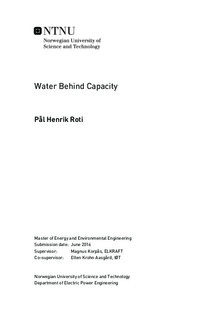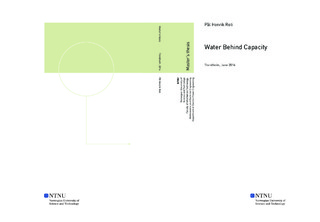| dc.description.abstract | When the power system becomes more dependent on intermittent renewable energy, the need
for ancillary services becomes larger. Therefore, the power producers ability to deliver reserves
has been analysed in this thesis. Additionally, the costs of delivering such services have been
evaluated, as these costs determine if it is profitable for hydro power producers to supply balancing
power instead of energy. Since hydro power is a well suited source for delivering balancing
power, and a major part of the Nordic power system, the amounts of reserves which can be
delivered from hydro power units have been the main topic of this thesis.
The thesis is based on the decision support tool SHOP, which is a short termoptimization model
for hydro power producers developed at SINTEF Energy Research, in addition to its newly developed
simulation funcionality. The model is one of the industry s most used tools for finding
the optimal amount of energy to be sold in the power market in every hour for the days to come.
However, the model is not adequate for deciding the amount of reserves to be be delivered, and
does not consider hydrological constraints when the reserves are activated. Therefore, the first
objective in this thesis has been to develop a methodology for assessing the amounts of reserves
which can be delivered. In order to do this, the methodology has been based on the excising
models, and the model functionalities have been utilized in innovative and non-standard ways.
Next, the second objective in this work has been to validate the methodology on illustrative and
realistic case studies.
Fromthe results in the analysis, it has been shown that the developed methodology successfully
assesses the amounts of reserves which can be delivered, and produces realistic results. Hence,
the results are not only verifying the methodology, but are also illustrating concepts which are
very valuable for market participants who are delivering ancillary services. Furthermore, it has
been shown that the costs and amounts of reserves which can be delivered froma hydro system
in the regulating power option market are strongly related to the amount of available water in
the system s reservoirs. Additionally, the hydro system s flexibility also plays an important role,
as more reserves can be delivered from a less constrained system. As more flexibility is available
when reserves are delivered from a hydro systemwhich consists of several cascaded plants, more reserves can typically be delivered from such systems, and at lower costs.
The analysis has been carried out in several steps. First, the expected number of hours which
the reserved capacity is activated has been found. This estimate is based on available historical
data of the Nordic power system, and statistical methods have been used to find the expected
number. Next, the maximum amount of capacity which can be activated from a hydro system
during the expected time period without emptying the system s reservoirs has been found. Finally,
the costs of delivering different amounts of reserves have been found. The analysis has
been carried out on two different hydro systems, where different amounts of generation capacity
have been reserved for the regulating power option market, and the amounts of available
water in the reservoirs have been varied.
At last, it has been shown that the amounts of reserves which actually can be delivered are limited,
even though the system easily can withhold more generation capacity from the generating
units. This is both due towater unavailability and violation of hydrological constraintswhen the
reserved capacity is activated. Hence, in order to obtain decision support tools which are well
suited for production scheduling in several markets, the excising models should be extended
to include algorithms which assess the volumes that can be delivered in the balancing markets
while considering the risk of violating relevant constraints. | |

